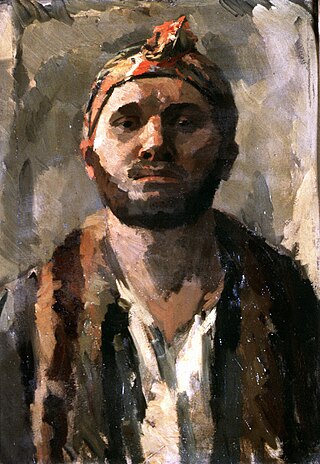Top Qs
Timeline
Chat
Perspective
René Beeh
German painter (1886–1922) From Wikipedia, the free encyclopedia
Remove ads
René Beeh (German: [ˈʁɛne be:], January 1886 − 23 January 1922) was a German draughtsman and painter from Alsace.[1] He was held in high esteem by his contemporaries and called "the coming genius" (das kommende Genie) by art historian Wilhelm Hausenstein,[2] but with his having died prematurely, he has been mostly forgotten.[3]
Remove ads
Life and work
Summarize
Perspective
Beeh was taught in the Fine Arts School in Strasbourg from 1900 until 1905,[4] then in the Academy of Fine Arts in Munich (student number 2936, registered on 9 May 1905),[5] where his teachers were Peter Halm, Hugo von Habermann and Franz von Stuck.[3] In 1910, he travelled to French Algeria where he stayed until 1911,[6] before journeying through Italy and Provence.[7] In 1914, he published a selection of letters from Algeria along with sixty drawings, under the title M'Barka. Malerbriefe aus Algerien mit sechzig Zeichnungen.[8][9]
During the First World War, Beeh was drafted as a surveyor for the Imperial German Army on the Western Front in Belgium (on the Ypres Salient)[10][11] and Northern France.[12] Some of his War drawings were published in the Munich review Zeit-Echo.[7] After the War, Beeh, suffering from depression, is thought to have destroyed much of his own work.[3] He died from a severe case of seasonal flu at the age of 36.[13]
Beeh was a member of the Neue Münchner Secession (New Munich Secession).[3] He was also friends with several members of the Strasbourg group of painters Groupe de Mai.[14][15]
In 1914, Beeh illustrated a book celebrating the centenary of Gottfried Keller,[16] and in 1919−1920, the novel Inferno by August Strindberg.[17][18] He also illustrated a 1918[19] edition of Jeremias Gotthelf's The Black Spider,[20] and he contributed to the periodical Münchner Blätter für Dichtung und Graphik ("Munich Journal for Poetry and Graphics") alongside Paul Klee, Heinrich Campendonk and Alfred Kubin.[21]
La Révolution
The artist's most ambitious surviving work is the large painting La Révolution ("The Revolution") (oil on canvas, 120.5 cm (47.4 in) x 156.5 cm (61.6 in), painted 1918–1919), an ominous depiction of the events of November 1918 in Strasbourg using solely tints and shades of ochre and brown. The painting shows a small group of men seen from very close who are grabbing rifles and seem ready to launch an assault; but instead of rushing forward towards the viewer, they are gazing at a figure in workwear, who sits motionless with an inscrutable expression. The action seems frozen and time appears suspended in the very moment where violence is breaking out.[22]
Remove ads
Posterity
In 2008, the Musée historique in Haguenau organised an exhibition of his works, the first in France since his premature death, 86 years before.[3][14][23] The Musée d'art moderne et contemporain of Strasbourg owns 100 works (as of 5 April 2024) by Beeh: 54 prints, 36 drawings and 10 paintings, among which two self-portraits, a portrait of the artist's father and of the artist's sister, and La Révolution.[24] The Los Angeles County Museum of Art currently owns 83 works by the artist, drawings and prints,[25] and the Museum of Modern Art currently owns 27 works, also drawings and prints.[1]
Remove ads
Gallery
- The Revolution (1918–1919)
- Brothel scene in Algeria (1915)
- French Legionnaire being stabbed by an Algerian (1915)
- Man sitting in a bar (before 1922)
- Trench (between 1915 and 1918)
- Dead End (project for Inferno by Strindberg, 1919)
References
Wikiwand - on
Seamless Wikipedia browsing. On steroids.
Remove ads







